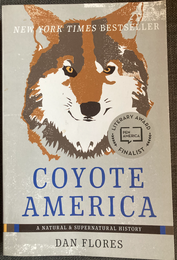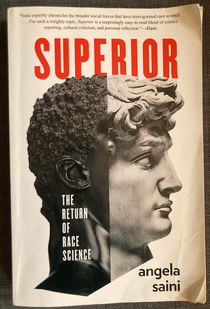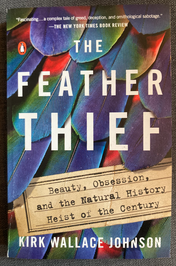|
My New Years’ resolution for 2020 was to read more nonfiction, but I didn’t initially envision starting a blog to write about all the books I didn’t have time or energy to read during my Ph.D. I posted more sporadically than I would have liked, but it was 2020, so I’m cutting myself some slack and calling my resolution a success. Here’s a look back at the science non-fiction books I read this year:
 Coyote America by Dan Flores Coyote America is a story of resilience and was a necessary contrast to the multiple books about extinction on this list. Coyotes will always be fascinating to me, and I regret not reading this book when I was an active coyote researcher.  Superior by Angela Saini Science has undeniably racist origins that persist today in a big way. This book wasn't from my backlog, but it should have been, especially given my background in population genetics. Rethink any "well- intended" study of human diversity and read this book.  Lab Girl by Hope Jahren While Hope Jahren can’t speak for everyone, Lab Girl certainly showcased many of the issues that young female science professors face in a world still dominated by white men. Jahren is not my favorite writer, but it took courage to tell her story, and I have a lot of respect for this book.  How to Clone a Mammoth by Beth Shapiro Beth Shapiro’s whimsical guide to the complicated and controversial science of de-extinction is probably my favorite of the books I reviewed this year. Still, I’m not fully convinced that bringing back anything that even slightly resembles a species that has been extinct for over 3,000 years is a good idea.  The Feather Thief by Kirk Wallace Johnson My full review is coming in January 2021, but The Feather Thief is an extraordinary story of natural history, a peculiar heist, and above all, the scientific value of museum collections. Welcoming in 2021 (finally)
Next year, I’m committing to a more regular schedule of one review per month. To keep the theme of the blog alive, approximately 2/3 of the books I read and write about will be from my “backlog.” But, to stay up to date on newer science books, every third post or so, I’ll review a book that wasn’t already on my shelf. In no particular order, some titles I’m looking forward to reading: Sally Ride: America's First Woman in Space by Lynn Sherr (backlog) Darwin’s Ghosts by Rebecca Stott (backlog) How to Tame a Fox and Build a Dog by Lee Alan Dugatkin & Lyudmila Trut (backlog) The Soul of an Octopus by Sy Montgomery (backlog) Why Fish Don’t Exist by Lulu Miller (new) The Secret Lives of Color by Kassia St. Clair (new) Happy New Year! Look for my first post of 2021, covering Kirk W. Johnson’s The Feather Thief, this January.
0 Comments
Why this book? I have never met or corresponded with Beth Shapiro, but I sure have heard a lot about her over the years. I could probably fill an entire post just on our tangential connections, but for the sake of everyone, I’ll keep it to one story: On a snowy afternoon in early 2014, on my first ever overnight trip to New Jersey, I was sitting in Eno Hall for a day of interviews with professors in the Princeton Ecology and Evolutionary Biology Department. During the sixth iteration of my spiel on my undergraduate research project, which involved extracting DNA from museum samples, I got a question that had not come up in my first five interviews: had I considered reaching out to Beth Shapiro for insights on the best extraction techniques for museum specimens? I had not. But, feeling the need to prove that I at least knew who she was, I commented instead on her move from Penn State to UC Santa Cruz at least two years earlier. The day after the interview, I wrote thank you notes to everyone I had spoken to and tried my darnedest to make them as specific as possible. In my note to interviewer number six, I kindly thanked him for the suggestion to contact Beth Shapiro. Two days later, I received the unofficial “you’re in” email from the department. Who is to say that this sequence of events had any real impact on, well, anything. But I like to think that my obscure knowledge of where Beth Shapiro was employed before 2014 had positively impacted my graduate school application. Despite all this, my loose professional connection to the author isn’t the primary reason I purchased this book. In my final year of graduate school, I started thinking about a new career in science publishing. Alison Kalett, the biology editor at Princeton University Press, was one of the first people I met for an informational interview about this crazy idea. Around the time we spoke in late 2018, I did a quick search for books she had worked on over the last few years, and that is how How to Clone a Mammoth ended up on my shelf. Mindset going in: I’m not going to deny that the prospect of bringing back the mammoth is “cool,” but my stance of de-extinction before I read this book was largely negative. That may be surprising, as my research investigated reintroduced populations of wolves following a period of total extinction in the wild for several years (red wolves) or extinction in a particular region for over six decades (Yellowstone wolves). While I stand behind these wolf reintroductions, reintroducing a species that has been completely extinct for over 3,000 years sounds so scientifically and politically challenging that it is hard to argue that the ecological benefits could be worthwhile. Nevertheless, I’m glad Shapiro took up the challenge and wrote this book. How the book stacked up: How to Clone a Mammoth is literally written as a “how-to” guide, with sequential chapters laying out the steps theoretically needed to resurrect an extinct species. As someone who works for a methods journal and spends her days reading technical protocols, I have a deep appreciation for this format, and it adds an extra element of fun- something that is missing from a lot of science books. With a spirit of cautious optimism, most of the book is dedicated to outlining the challenges associated with de-extinction and carefully walking through the relevant science. Shapiro emphasizes early on that the title of the book is a misnomer- it is not actually possible to clone a mammoth. Cloning (much like the term “evolution”) has a precise scientific definition that hasn’t been properly communicated to most non-scientists. I blame the sci-fi industry. In a scientific context, “cloning” doesn’t just mean to make a copy of a living thing; it refers to one specific method of removing all the DNA from one cell and transferring it to another cell. Cloning a mammoth, in the true technical sense of the word, hinges on finding a mammoth cell with all the DNA still intact, which is highly unlikely given how DNA degrades. Shapiro and her colleagues in de-extinction research are trying to achieve something distinct from bringing back a living, breathing mammoth. Their focus is on ecological restoration, not the restoration of a nominal species. Their best-case scenario is the genetic engineering and eventual reintroduction of an extra hairy elephant-like animal that isn’t technically a mammoth but fills a similar ecological niche. While not without substantial challenges, this goal is theoretically achievable with existing technology, namely CRISPR/Cas9. CRISPR made headlines (again) this fall after the two scientists who led the initial effort behind the method, Jennifer Doudna and Emmanuelle Charpentier, won the Nobel prize for chemistry. While it is undoubtedly superior to the previous genome engineering methods, that doesn’t mean CRISPR is “easy” to pull off. I knew plenty of people in grad school who were frustrated to no end while trying to get their CRISPR lines up and running, and Shapiro emphasizes this hard reality. In collaboration with George Church (the eccentric Harvard professor who recently vaccinated himself for COVID with an untested DIY shot), Shapiro and other de-extinctionists are actively working to make CRISPR more tractable for editing large segments of the genome. However, these efforts are still on-going and represent only one piece of a much larger story. Where the “mammoths” would eventually be reintroduced and how they would be regulated by the relevant governments remain open questions. Final thoughts:
Shapiro ends the book with an FAQ on the common objections to reintroducing extinct species. While she did anticipate and thoroughly answer many of my questions, I can’t say that I’ve been definitively swayed towards supporting de-extinction efforts of this magnitude. I gained a much clearer understanding of de-extinction research, and I appreciated Shapiro’s emphasis on ecological role rather than any particular species identity. Still, I’m not fully convinced that the scientific and political hurdles needed for de-extinction could be cleared in my lifetime or even this century. I’d also like to know more about the hypothesized ecological benefits (and risks) of reintroducing long-extinct species, but I concede that deciphering complex ecological interactions wasn’t the point of the book. In addition to those interested in biodiversity, I highly recommended this book for anyone interested in how genome editing works. Shapiro’s primer on CRISPR for a general audience is one of the best that I’ve read, and she certainly didn’t gloss over how challenging it actually is to make changes to the genome. |


 RSS Feed
RSS Feed
